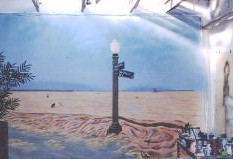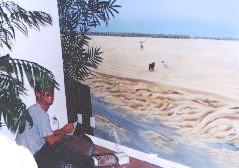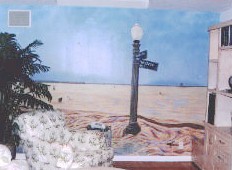| Go back to previous page | |
| Forum URL: | http://www.truefresco.com/cgidir/dcforum/dcboard.cgi |
| Forum Name: | Murals & Trompe L'oeil |
| Topic ID: | 1 |
|
#0, Mural & Canvas - How To? Posted by admin on 30-Mar-01 at 10:47 AM "Murals on Canvas - A How-To!" #1, Sagging Canvas (mural) Posted by admin on 19-Nov-03 at 10:54 PM In response to message #0
#2, RE: Mural & Canvas - How To? Posted by marj on 22-Jan-04 at 09:16 AM In response to message #0 Hi! Could I use this wallpaper glue technique for installing a less than wall sized mural (3x6 feet)? What would the edge look like? Would it need a frame of some sort to finish it off or is there a way to make it look like it is painted directly on the wall. I have not started or bid the project yet. A friend said to paint it on board and then cut into the wall to make it flush... but this seems complicated and rather extreme, and would make transport more difficult. For such a resonable size should I charge a bit more and paint it directly on the wall? If I were to do this what surface preparation should I do to the existing wall? Lastly does being directly painted on the wall as opposed to being hung like wallpaper effect if it is considered an improvement to the house value? #3, RE: Mural & Canvas - How To? Posted by admin on 24-Jan-04 at 02:04 AM In response to message #2 Painting on canvas and installing is always better since it can be removed and placed elsewhere, as of improvement of the house value... it is the metter of opinion, but you can always tell the client that since it is removable therefore it is collectable and it is rather investment than improvement. when it is painted directly on the wall it is just a decoration which is a matter of taste (one person likes the other one does not) #4, RE: Mural & Canvas - How To? Posted by Nadja on 29-Jan-04 at 12:49 PM In response to message #3 Hi, #5, RE: Mural & Canvas - How To? Posted by Tuema on 28-Nov-06 at 03:45 PM In response to message #0 I have heard a lot about a "non-woven" material (sometimes called parachute cloth) that is used for large outdoor murals. It is painted in the studio and later mounted using acryic gel. I would like details if anyone has tried this technique or knows where to buy this material. #6, RE: Mural & Canvas - How To? Posted by Tuema on 28-Nov-06 at 03:55 PM In response to message #0 "Murals on Canvas - A How-To!" #7, RE: Mural & Canvas - How To? Posted by admin on 30-Nov-06 at 08:34 AM In response to message #6 it is all the same (parachute, muslin) some last's longer then others 100years as oppose to 50. For example if you paint in oils you would want to use linen instead of canvas - oil will "eat" canvas eventually - does not matter how well you prime it. #9, RE: Mural & Canvas - How To? Posted by LWolff on 08-Oct-14 at 09:19 AM In response to message #0 Great article, thank you!! I have been commissioned to do a 10'hx17'w mural on canvas to be installed on a well sheltered exterior wall here in Oregon. I am about to purchase the one piece poly mural product in the size I need from Lake arts mural canvas. I'll paint the mural in my studio and clear coat it with an exterior rated product. The existing wall is stucco over cement that has been painted several times over the years and the location is a large covered entrance to a train depot which will become a restaurant. If I prep the wall with a heavy primer then simply use the clay based wallpaper adhesive, should this be sufficient? I am comfortable with the installation with some helpers but am looking into a pro wall paper hanger. I originally wanted the wall to have a wood underlayment "skin" applied to insure that the glue would have good adherence but am wondering if that is an unnecessary step. It only goes below freezing a very few times over the winter, mostly just a lot of general moisture in the air but again, this location will be nicely sheltered. I would appreciate any helpful comments, thank you!!!! | |


